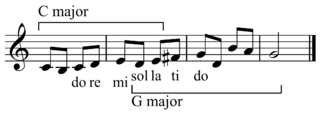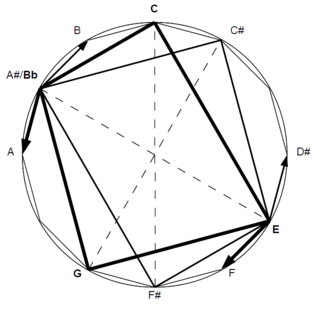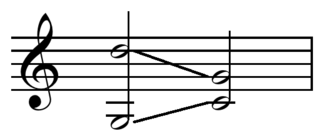In a musical composition, a chord progression or harmonic progression is a succession of chords. Chord progressions are the foundation of harmony in Western musical tradition from the common practice era of Classical music to the 21st century. Chord progressions are the foundation of popular music styles, traditional music, as well as genres such as blues and jazz. In these genres, chord progressions are the defining feature on which melody and rhythm are built.

In music, modulation is the change from one tonality to another. This may or may not be accompanied by a change in key signature. Modulations articulate or create the structure or form of many pieces, as well as add interest. Treatment of a chord as the tonic for less than a phrase is considered tonicization.
Modulation is the essential part of the art. Without it there is little music, for a piece derives its true beauty not from the large number of fixed modes which it embraces but rather from the subtle fabric of its modulation.
A secondary chord is an analytical label for a specific harmonic device that is prevalent in the tonal idiom of Western music beginning in the common practice period: the use of diatonic functions for tonicization.

Bassline is the term used in many styles of music, such as blues, jazz, funk, dub and electronic, traditional, or classical music for the low-pitched instrumental part or line played by a rhythm section instrument such as the electric bass, double bass, cello, tuba or keyboard.
In Western musical theory, a cadence is the end of a phrase in which the melody or harmony creates a sense of full or partial resolution, especially in music of the 16th century onwards. A harmonic cadence is a progression of two or more chords that concludes a phrase, section, or piece of music. A rhythmic cadence is a characteristic rhythmic pattern that indicates the end of a phrase. A cadence can be labeled "weak" or "strong" depending on the impression of finality it gives. While cadences are usually classified by specific chord or melodic progressions, the use of such progressions does not necessarily constitute a cadence—there must be a sense of closure, as at the end of a phrase. Harmonic rhythm plays an important part in determining where a cadence occurs.
The term sixth chord refers to two different kinds of chord, the first in classical music and the second in modern popular music.
In music theory, a dominant seventh chord, or major minor seventh chord, is a seventh chord, usually built on the fifth degree of the major scale, and composed of a root, major third, perfect fifth, and minor seventh. Thus it is a major triad together with a minor seventh, denoted by the letter name of the chord root and a superscript "7". An example is the dominant seventh chord built on G, written as G7, having pitches G–B–D–F:
The passamezzo moderno, or Gregory Walker was "one of the most popular harmonic formulae in the Renaissance period, divid[ing] into two complementary strains thus:"
A modal frame in music is "a number of types permeating and unifying African, European, and American song" and melody. It may also be called a melodic mode. "Mode" and "frame" are used interchangeably in this context without reference to scalar or rhythmic modes. Melodic modes define and generate melodies that are not determined by harmony, but purely by melody. A note frame, is a melodic mode that is atonic, or has an unstable tonic.

In music theory, chord substitution is the technique of using a chord in place of another in a progression of chords, or a chord progression. Much of the European classical repertoire and the vast majority of blues, jazz and rock music songs are based on chord progressions. "A chord substitution occurs when a chord is replaced by another that is made to function like the original. Usually substituted chords possess two pitches in common with the triad that they are replacing."
The ragtime progression is a chord progression characterized by a chain of secondary dominants following the circle of fifths, named for its popularity in the ragtime genre, despite being much older. Also typical of parlour music, its use originated in classical music and later spread to American folk music. Growing, "by a process of gradual accretion. First the dominant chord acquired its own dominant...This then acquired its dominant, which in turn acquired yet another dominant, giving":

The passamezzo antico is a ground bass or chord progression that was popular during the Italian Renaissance and known throughout Europe in the 16th century. The progression is a variant of the double tonic: its major mode variant is known as the passamezzo moderno.

A level, also "tonality level", Gerhard Kubik's "tonal step," "tonal block," and John Blacking's "root progression," is an important melodic and harmonic progression where melodic material shifts between a whole tone above and a whole tone below the tonal center. This shift can occur to both neighboring notes, in either direction, and from any point of departure. The steps above and below the tonic are often called contrasting steps. A new harmonic segment is created which then changes the tonality but not necessarily the key.

In music, consecutive fifths or parallel fifths are progressions in which the interval of a perfect fifth is followed by a different perfect fifth between the same two musical parts : for example, from C to D in one part along with G to A in a higher part. Octave displacement is irrelevant to this aspect of musical grammar; for example, a parallel twelfth is equivalent to a parallel fifth.

The Andalusian cadence is a term adopted from flamenco music for a chord progression comprising four chords descending stepwise – a iv–III–II–I progression with respect to the Phrygian mode or i–VII–VI–V progression with respect to the Aeolian mode (minor). It is otherwise known as the minor descending tetrachord. Traceable back to the Renaissance, its effective sonorities made it one of the most popular progressions in classical music.

In jazz, a turnaround is a passage at the end of a section which leads to the next section. This next section is most often the repetition of the previous section or the entire piece or song.
In classical music theory, the English cadence is a contrapuntal pattern particular to the authentic or perfect cadence. It features a flattened seventh scale degree against the dominant chord, which in the key of C would be B♭ and G–B♮–D.
The '50s progression is a chord progression and turnaround used in Western popular music. The progression, represented in Roman numeral analysis, is: I–vi–IV–V. For example, in C major: C–Am–F–G. As the name implies, it was common in the 1950s and early 1960s and is particularly associated with doo-wop. The first popular song to use the progression was Blue Moon, written in 1934. This inspired Heart and Soul in 1938 and Blueberry Hill in 1940.

In music and musical analysis, a subsidiary chord is an elaboration of a principal harmonic chord in a chord progression.

Parallel and counter parallel chords are terms derived from the German to denote what is more often called in English the "relative", and possibly the "counter relative" chords. In Hugo Riemann's theory, and in German theory more generally, these chords share the function of the chord to which they link: subdominant parallel, dominant parallel, and tonic parallel. Riemann defines the relation in terms of the movement of one single note:
The substitution of the major sixth for the perfect fifth above in the major triad and below in the minor triad results in the parallel of a given triad. In C major thence arises an apparent A minor triad, D minor triad (Sp), and E minor triad (Dp).

 Play (help·info): double tonic a whole tone apart, on the upper note (A).
Play (help·info): double tonic a whole tone apart, on the upper note (A).








